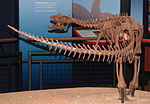Phyllodon is a genus of moss. Goffinet, B.; Buck, W. R.; Shaw, A. J. (2008). "Morphology and Classification of the Bryophyta". In Goffinet, B.; Shaw,...
2 KB (69 words) - 15:58, 12 September 2023
1973 in paleontology (section Plants)
Upper Jurassic of Portugal, with a description of a hypsilophodontid (Phyllodon henkeli gen. et sp. nov.) from the Guimarota Lignite". Memória Serivoços...
18 KB (919 words) - 02:17, 27 June 2024
developed sharp ridges that allowed neornithischians to break down tougher plant food than other dinosaurs. Neornithischians include a variety of basal forms...
13 KB (818 words) - 03:24, 5 August 2024
Peterson, Fred; Turner, Christine E (2004-05-15). "Jurassic "savannah"—plant taphonomy and climate of the Morrison Formation (Upper Jurassic, Western...
63 KB (7,305 words) - 19:27, 21 August 2024
Norian to Rhaetian) Wales Would have lived on a dry limestone island Phyllodon 1973 Alcobaça Formation (Late Jurassic, Kimmeridgian) Portugal The front...
92 KB (3,836 words) - 12:35, 29 July 2024
typical for a herbivore, indicating Chilesaurus was a plant-eater. Another adaptation for eating plants is the backward-pointing pubic bone in the pelvis...
13 KB (1,277 words) - 17:01, 10 June 2024
such as goethite, feldspar minerals, quartz, and gypsum, as well as some plant fragments; carbon, nitrogen, and phosphorus, chemical elements important...
51 KB (5,387 words) - 19:24, 22 August 2024
49–52. doi:10.34637/RX8A-5283. hdl:10400.9/3830. J. Pais Upper Jurassic Plants from Cabo Mondego (Portugal) Separata do Boletim da Sociedade Geologica...
45 KB (2,602 words) - 22:57, 11 August 2024
low-energy transport, but the lack of any damage to the bones, or signs of plant root damage or insect boring holes, indicate the remains were not exposed...
33 KB (3,590 words) - 21:59, 22 August 2024
cheek teeth of heterodontosaurids are clearly adapted for grinding tough plant material, their diet may have been omnivorous. The pointed premaxillary...
45 KB (4,619 words) - 15:40, 11 May 2024








